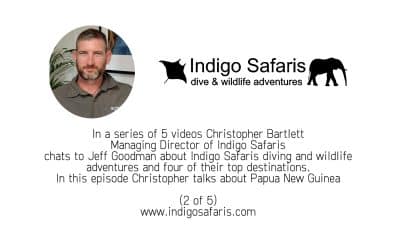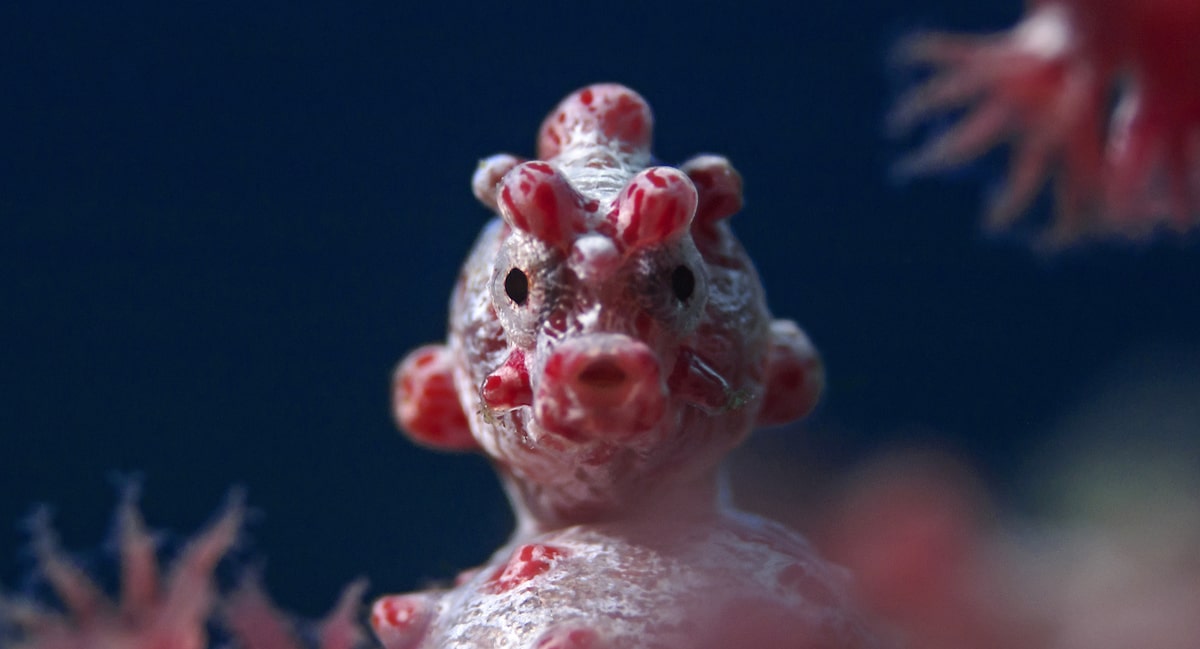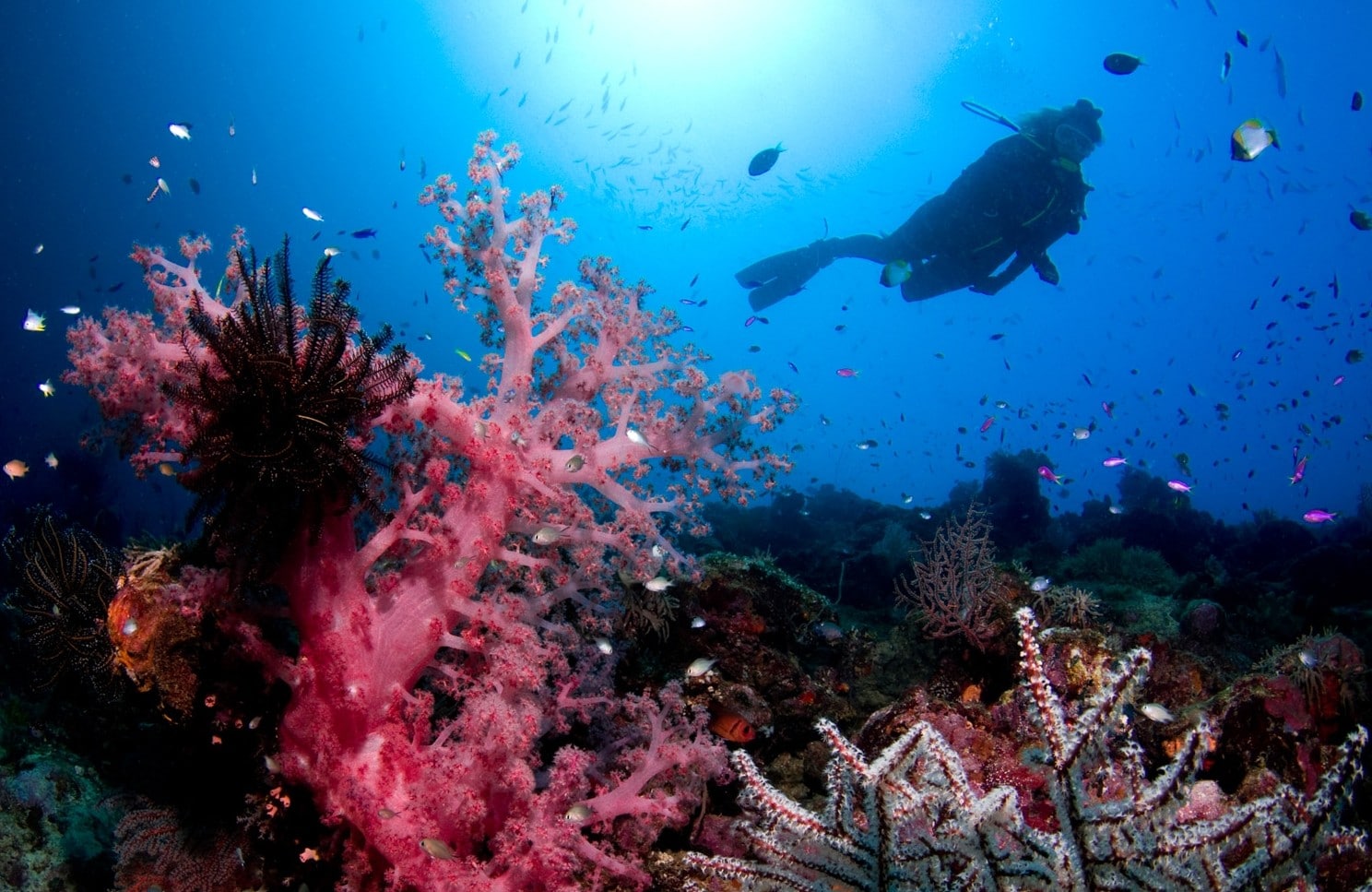Travel Stories
In love with (a bommy called) Suzy
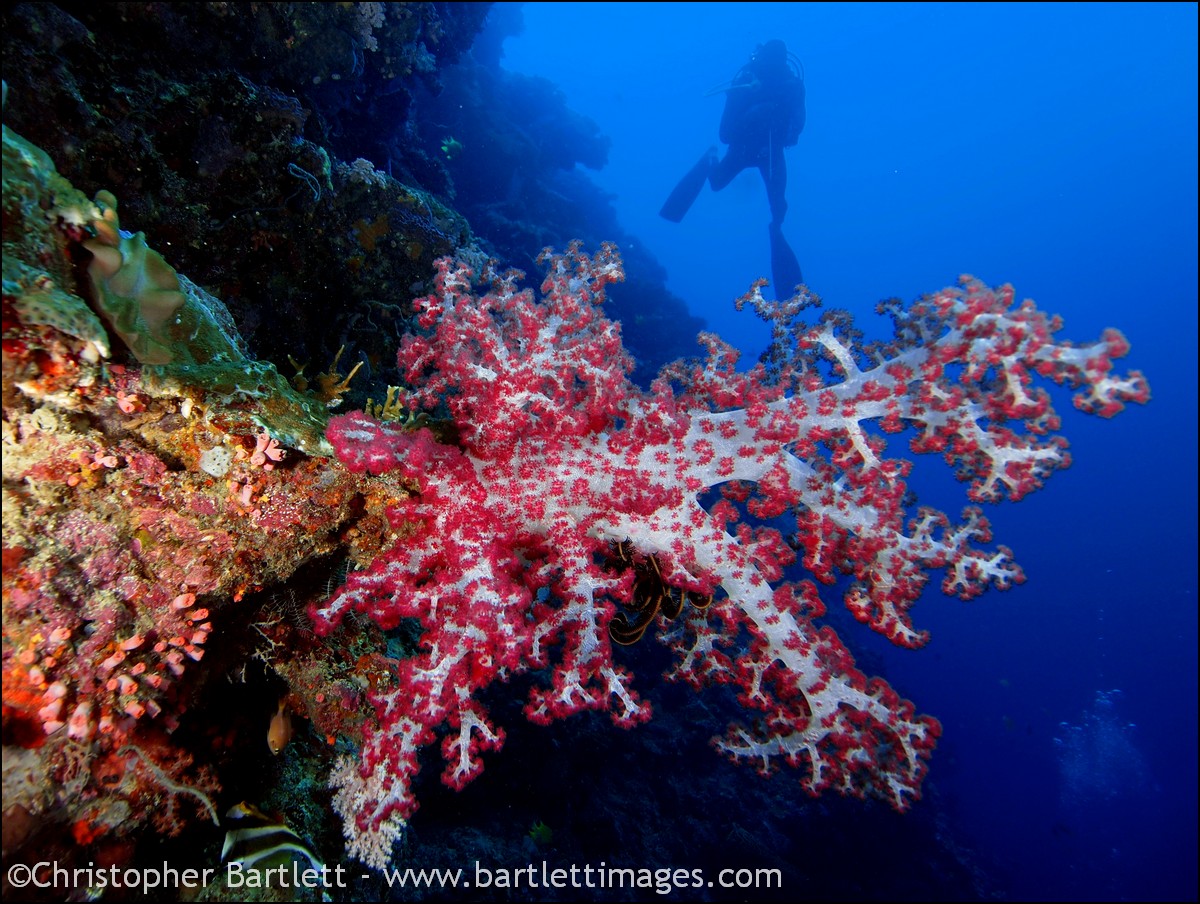
Is it possible to fall in love with a dive site? Christopher Bartlett visits Loloata Island Resort in Papua New Guinea to find out
She’s bright and colourful on surface, but deep and complex the more you get to know her. Her charms are numerous and sometimes mysterious, yet she’s always easy-going and welcoming.
If she sounds like the ideal girl, it’s because she is – almost. Suzy is in fact a bommy and a dive site on the barrier reef outside Bootless Bay, Port Moresby.
I’d heard of Suzy’s charms over dinners in Paris, lunches in London, and coffee in Madrid. The few aficionados of adventure and connoisseurs of coral who’d witnessed her beauty recalled their encounters with misty, wistful eyes. I promised to myself that on my next visit to PNG I would check her out.
Sometimes legends are created from little substance, exaggerations creep in, embellishments are made. To top it off, I would be spending my 40th birthday at Loloata Island Resort. Festive expectations are often raised, anticipation runs high, and then the party goes off with a pfffft rather than a resounding pop. Would Suzy be the same?
My party plans weren’t in synch with the dive plan (although I was more than happy to just be getting back into PNG waters again). A group was in and had requested morning dives at Pumpkin Patch and Dinah’s Delight with a post-prandial potter around Lion Island. Being my first dive in five months, I missed part of Pumpkin Patch readjusting my kit, getting used to my new BCD, tuning back in with the water and my camera. I did see the Pygmy seahorse, the crocodile fish, and an olive sea snake, though with a not inconsiderable current my photos were never going to be keepers.
Dinah’s Delight, named after the wife of PNG diving pioneer Bob Halstead, was true to its name. The gorgonian fan-filled gullies were gorgeous and harboured my first ever sighting of a tasselled wobbegong shark, it’s mottled camouflage not evading the eye of our dive guide, Roy. It was an unexpected birthday treat, and I marvelled at the elaborated fronds protruding from below its bottom lip. Within the mass of tassels are branched nasal barbels and grooves that channel surrounding water to the shark’s mouth. The barbels are perfectly positioned to help these bottom-dwelling sharks detect a variety of bottom-dwelling prey such as crabs, lobsters, cephalopods, echinoderms and fishes. Wobbegongs have even been documented eating bamboo sharks of a length similar to their own. Although believed to be a rare occurrence, with a jaw structure that facilitates dislocation, a large gape, and sharp, rearward-pointing teeth, wobbegongs can grasp a relatively large prey before swallowing it whole.
[wppa type=”slideonlyf” album=”6″ size=”auto” align=”center”][/wppa]
After a lobster-tail lunch back at Loloata we departed for nearby Lion Island. The island is the location of a couple of deliberately sunken fishing trawlers that host some interesting fish life, and a shallow sandy slope interspersed with patches of seagrass that hide a host of small and interesting critters. A spinecheek anemonefish posed for a birthday photo, a porcelain crab modelled perfectly for me, a luridly coloured peacock mantis shrimp poked its bright blue eyes out of its tunnel in the sand, and a shrimp bearing eggs that I had never seen before (that turned out to be a Holthuis’ shrimp) hopped around the tentacles of her host anemone. All in all, I didn’t feel like I’d missed anything at all and was most content with the underwater birthday bounty I had received.
The next morning Roy and Raga gave us our daily diving menu: End Bommy, Suzy’s Bommy, and the wreck of the MV New Marine. Three nautical miles out to sea on the outer barrier reef, End Bommy’s abundant life is fed by the tides that bring nutrients around and over it. After mooring on a pin on the main reef, we started finning across 40 metres of blue water. Before I was halfway across, I could make out the wall opposite me. It was certainly well-nourished; with gorgonian fans, pink sea whips, tubastraea and soft coral trees perched on its sides. The tide hadn’t quite started to go out, but there were still plenty of fish. Crinoids, also called feather stars, hung off gorgonians and sea whips with their limbs extended, feeding on plankton in the gentle current. The colours were beautiful.
On the way back I started sorting through the 100-odd images I’d taken, thinking that we were done, Raga led us off on a short diversion. We’d already been down for 60 minutes, so it had to be something good. And it was. The largest congregation of bubble-tip anemones I have ever seen, playing host to over a hundred dusky anemonefish. Incredible.
How was Suzy’s going to beat that? An hour later the outgoing tide was in full flow, pulling nutrients from the inshore waters out to the deep, and pulling in a lot of hungry fish. Big schools of deep-bodied and twin-striped fusiliers plunged down the walls, shimmering in the sunlight. We followed them down about 30 metres looking for pygmy seahorses in the plentiful fans.
In terms of colour, Suzy’s matched End Bommy pink for pink, whip for whip, feather star for feather star and fan for fan. There was no luck on the pygmy front, but there was so much else to take in I was glad not to be distracted from it. Raga pointed out longnose hawkfish in the fan where he sometimes found seahorses. It looked quite chuffed to me, like it’d just had a nice snack. Nearby a Harlequin sweetlips was enjoying the attentions of a cleaner wrasse.
I found it hard to pick a wide-angle shot to photograph. There were a plethora of possibilities and the best way to get a cracking image is to pick one and take it many times, varying the angle slightly, trying different settings, and seeing if a colourful fish might swim into the frame. I was a fat kid in a cake shop trying to fill my boots. At 30 metres my time at the photographic buffet was soon gone though, and I moved up the wall, conscious that I needed to save some nitrogen credit for the top of the bommy, 13 metres below the surface. Above me the dark silhouettes of hundreds of sweetlips swirled, looking for their lunch, and a large emperor darted into a pack of fusiliers. A few choice expletives of wonder passed through my mind as I marvelled.
My reverie was broken by Roy banging on his tank above me. Up at 15 metres, merrily sitting on a small shelf on the bommy, was one of a photographer’s most sought-after subjects, and a Loloata special: the lacy scorpionfish (aka Merlet’s scorpionfish, Rhinopias aphanes). Covered with skin tags that mimic the algae or soft coral and crinoids of its immediate surroundings, its colouring is a maze-like camo pattern with white spots under each eye. This decoy eye enables the predator to watch its prey without detection, lying wait, ready to spring its ambush. The first few spines of the lateral fins have evolved into a sort of articulating toe with which they hook into the substrate and pull themselves along. By flopping about the bottom, other fish will discount the movements as flotsam or a wounded fish and come in close to investigate. The two white decoy spots below the eyes are distracting enough to mislead the prey. And as the unsuspecting fish approaches to investigate, the Rhinopias carefully watches, gauges the distance, and then all at once, drops its jaws and inhales the fish so quickly it actually pulls in a mass of water, creating a strong vacuum, making it impossible for the intended prey to escape.
The Rhinopias safely captured on my SD card, I glanced at my dive computer. An ominious “1” stared back at me. Time to go shallower. I passed the throng of lined sweetlips and hovered six metres above the top of the bommy, frustrated at not being able to get close enough to snap the fish, but enchanted by the action all around. Round the other side of the bommy a large school of silvery batfish swept back and forth, also looking for a feed. The place was buzzing. Loloata’s dive site description for Suzy’s says “superlatives cannot describe this dive site”. I concurred and wanted to go back.
I would have to wait, however, as Roy and Raga had more sites to show me. The MV New Marine is a fishing trawler sunk as an artificial reef close to the resort that has swarms of juvenile barracuda patrolling around it and lionfish hanging around the winch gear. It makes for an easy afternoon dive, as does the wreck of a Boston A-20 Havoc that crashed during the Second World War, and the great muck diving site in front of Lion Island.
The signature wreck dive though has to be the MV Pacific Gas. A 65-metre long gas tanker than was sunk in 1986, her bow sits at 15 metres deep, the top of the bridge is at 25 metres, and the rudder sits on the sandy bottom down at 44 metres. Descending down the mooring line to the bow, the bridge and cabin section look massive with a diver to provide some perspective. The mast and bow have some great corals, including a small fan hosting ornate ghost pipefish; there are resident lionfish and leaffish, and barracuda are common visitors.
My pygmy seahorse photography fix had yet to be sated, so a dive at Quayle’s reef was planned during which I spent my time with two fish. A Barbigant’s pygmy seahorse and a rockmover wrasse; both difficult species to record. The latter moves around back and forth in an apparently haphazard manner as if washed by the current, and the pygmy seahorse presents a challenge due to the fact that it is both rare and tiny. At up to 25 mm tall, the knobbly, slightly pot-bellied Barbigant is the daddy of the pygmy seahorses, but the individual at Quayle’s was more like 15 mm, shy, and probably a bit ticked off by the not so hot buoyancy control of the two divers who went before me. Still, with no-one else left in the queue, I could take my time and wait for the angle I wanted, a front-on view to show the mouth. I ended up watching this fascinating creature for 20 minutes, kneeling in the sand.
Pygmy seahorses are the only fish where the male become truly pregnant, nurturing the eggs in a brood pouch for at least 10 days and the female stays with her man for the duration of gestation. Males can even get stretch marks and although not mates for life, a happy couple can re-mate within 30 minutes of the male giving birth to their young.
Having seen one of the smallest fish in the ocean, Raga thought I needed something bigger. Down on Big Drop, we paid a visit to a big Pacific goliath grouper (Epinephelus quinquefasciatus). It reaches a length of 2.5 m and can weigh as much as 360 kg and to get this big it feeds on crustaceans, other fish, octopuses and young sea turtles. Definitive study into their reproductive behaviour has yet to be conducted but it is believed that like rest of the grouper family they are protogynous hermaphrodites, where all juveniles are female, the largest female in a territory become male when the resident male dies. Being this big, the fish wasn’t fazed by our presence and sat on the bottom as we pulled up alongside. Comparing it to Raga just behind it, our fella was around two metres long, yet another very impressive find.
On the last day we returned to Suzy. I mean Suzy’s Bommy. I no longer think or her / it as a large lump of rock covered in coral. All the fish were still there, with a couple of stonefish to boot, and the corals were just as captivating. I have always been a diver who avoided “going into deco” (building up a level of nitrogen in the body that makes a safety stop compulsory), and had managed to be a good boy for over 1500 dives around the world. Suzy bewitched me and took my deco cherry. I did not want to leave her. In my mind the bommy has taken on her own persona and aura, she is an underwater goddess of marine diversity and health. Sometimes I dream about her and I get a funny feeling in my chest. I’m in love with a bommy called Suzy.
Papua New Guinea travel: PNG is three hour’s flight time north of Australia, six hours from Singapore, and has weekly and twice weekly direct flights from a range of destinations like Manila, Cebu, Bali, Sydney, Cairns, Hong Kong and Tokyo. Within PNG, the best way (and often only) way to get around is by air either with Air Niugini or Airlines of PNG. Best of PNG put together tailor-made dive trips that can also take in the best Sing-Sings (cultural festivals) on the PNG calendar, trekking up Mt Wilhelm or the Kokoda Trail, and Sepik River expeditions. www.bestofpng.com
Blogs
Northern Red Sea Reefs and Wrecks Trip Report, Part 2: Wall to Wall Wrecks

Jake Davies boards Ghazala Explorer for an unforgettable Red Sea diving experience…
The second day’s diving was a day full of wreck diving at Abu Nuhas, which included the Chrisoula K, Carnatic, and Ghiannis D. The first dive of the day was onto the Chrisoula K, also known as the wreck of tiles. The 98m vessel remains largely intact where she was loaded with tiles which can be seen throughout the hold. The stern sits at 26m and the bow just below the surface. One of the highlights of the wreck is heading inside and seeing the workroom where the machinery used for cutting the tiles are perfectly intact. The bow provided some relaxing scenery as the bright sunlight highlighted the colours of the soft coral reef and the many reef fish.

Following breakfast, we then headed to the next wreck, which was the Carnatic. The Carnatic is an 89.9m sail steamer vessel that was built in Britain back in 1862. She ran aground on the reef back in 1869 and remains at 27m. At the time, she was carrying a range of items, including 40,000 sterling in gold. An impressive wreck where much of the superstructure remains, and the two large masts lay on the seafloor. The wooden ribs of the hull provide structures for lots of soft corals, and into the stern section, the light beams through, bouncing off the large shoals of glass fish that can be found using the structure as shelter from the larger predators that are found outside of the wreck.

The final wreck at Abu Nuhas was the Ghiannis D, originally called ‘Shoyo Maru,’ which was 99.5m long and built in Japan back in 1969 before becoming a Greek-registered cargo ship in 1980. The ship then ran aground on the reef on April 19th, 1983, and now sits at the bottom at a depth of 27m. Heading down the line, the stern of the ship remains in good condition compared to the rest of the hull. The highlight of the wreck, though, is heading into the stern section and down the flights of stairs to enter the engine room, which remains in good condition and is definitely worth exploring. After exploring the interior section of the ship, we then headed over to see the rest of the superstructure, where it’s particularly interesting to see the large table corals that have grown at the bow relatively quickly considering the date the ship sank. After surfacing and enjoying some afternoon snacks, we made sure everything was strapped down and secured as we would be heading north and crossing the Gulf of Suez, where the winds were still creating plenty of chop.

The next morning, it was a short hop to Ras Mohammed Nature Reserve for the next couple of days of diving. The 6am wake-up call came along with the briefing for the first site we would be diving, which was Shark & Yolanda. The low current conditions allowed us to start the dive at Anemone City, where we would drift along the steep, coral-filled wall. These dives involved drifts, as mooring in Ras Mohammed wasn’t allowed to protect the reefs. As a dive site, Shark & Yolanda is well-known and historically had a lot of sharks, but unfortunately not so many in recent years, especially not so early in the season. However, there was always a chance when looking out into the blue.

The gentle drift took us along the steep walls of the site, with plenty of anemone fish to be seen and a huge variety of corals. It wasn’t long into the dive before we were accompanied by a hawksbill turtle, who drifted with us between the two atolls before parting ways. Between the two reefs, the shallow patch with parts of coral heads surrounded by sand provided the chance to see a few blue-spotted stingrays that were mainly resting underneath the corals and are always a pleasure to see. With this being the morning dive, the early sunlight lit up the walls, providing tranquil moments. Looking out into the blue, there was very little to be seen, but a small shoal of batfish shimmering underneath the sunlight was a moment to capture as we watched them swim by as they watched us.

Towards the end of the dive, we stopped at the wreck of the Jolanda where the seafloor was scattered with toilets from the containers it was carrying. This provided a unique site to make a safety stop, which was also accompanied by a large barracuda slowly swimming by, along with a hawksbill turtle calmly swimming over the reef as the sun rays danced in the distance.
For the next dive, we headed north to the Strait of Tiran to explore the reefs situated between Tiran Island and Sharm El Sheik, which were named after the British divers who had found them. We started on Jackson before heading to Gordons Reef, where we also did the night dive. All the atolls at these sites provided stunning, bustling coral reefs close to the surface and steep walls to swim along, which always provided the opportunity to keep an eye out for some of the larger species that can be seen in the blue. Midwater around Jackson Reef was filled with red-toothed triggerfish and shoals of banner fish, which at times were so dense that you couldn’t see into the blue. Moments went by peacefully as we enjoyed the slow drift above the reef, watching these shoals swim around under the mid-afternoon sun.

The night dive at Gordon’s Reef was mainly among the stacks of corals surrounded by sand, which was great to explore under the darkness. After some time circling the corals, we came across what we were really hoping to find, and that was an octopus hunting on the reef. We spent the majority of the dive just watching it crawl among the reef, blending into its changing surroundings through changes in colour and skin texture. It’s always so fascinating and captivating to watch these incredibly intelligent animals, in awe of their ability to carry out these physical changes to perfectly blend into the reef. Before we knew it, it was time to head back to the boat to enjoy a well-deserved tasty dinner prepared by the talented chefs onboard.
Check in for the 3rd and final part of this series from Jake tomorrow!
To find out more about the Northern Red Sea reef and wrecks itineraries aboard Ghazala Explorer, or to book, contact Scuba Travel now:
Email: dive@scubatravel.com
Tel: +44 (0)1483 411590
Photos: Jake Davies / Avalon.Red
Blogs
Northern Red Sea Reefs and Wrecks Trip Report, Part 1: Welcome to Adventure
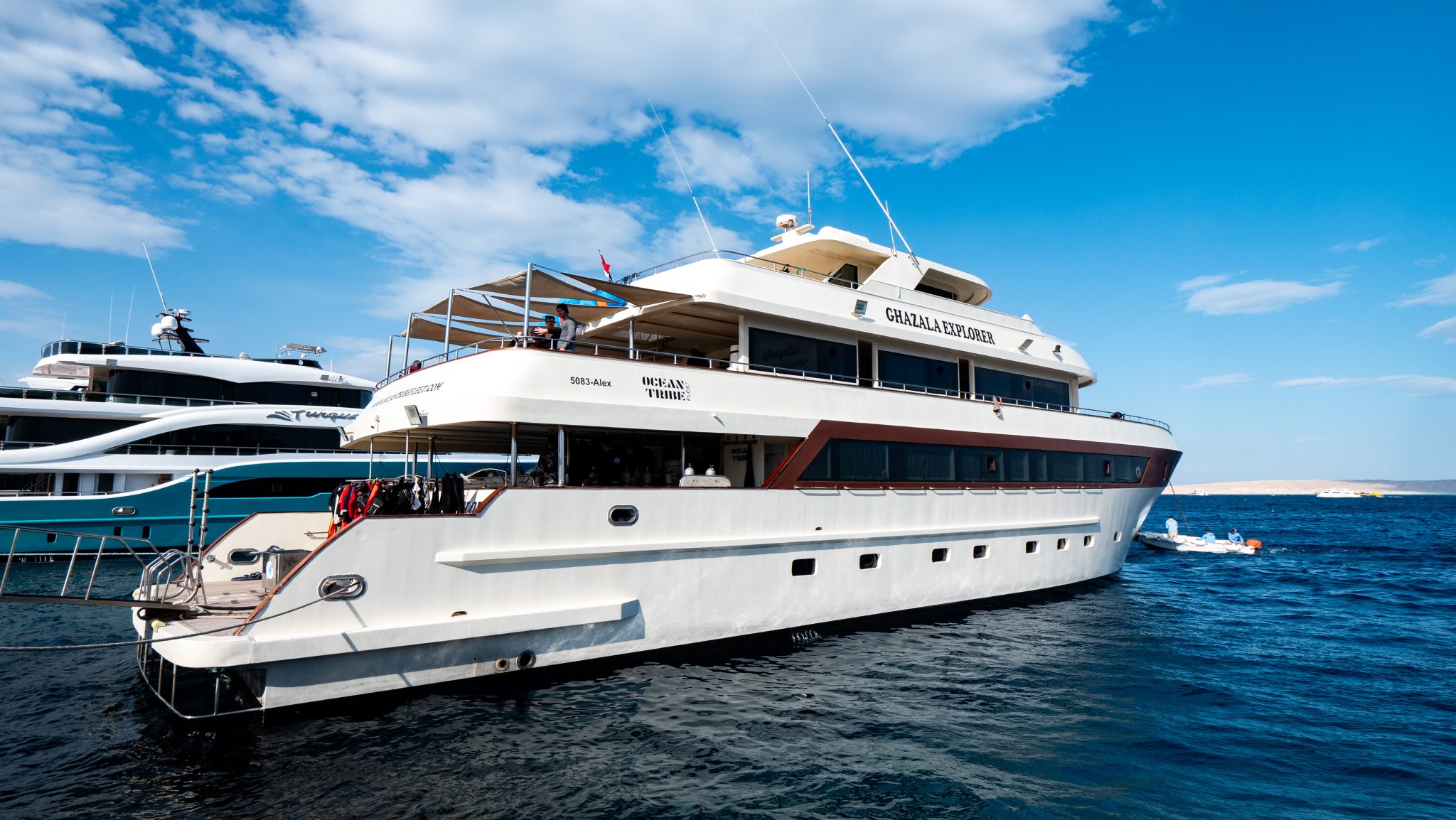
Jake Davies boards Ghazala Explorer for an unforgettable Red Sea diving experience…
The Red Sea is known for its range of dives, from bright, colourful reefs with a diverse array of reef species to world-famous wrecks scattered along its numerous atolls. The reefs and wrecks of the North Red Sea are one of the best ways to experience many of these.
Organised by dive tour operator specialist Scuba Travel, Ghazala Explorer was going to be home for the week for this exciting trip, a 37m steel-hulled vessel with top-class reviews by previous guests.
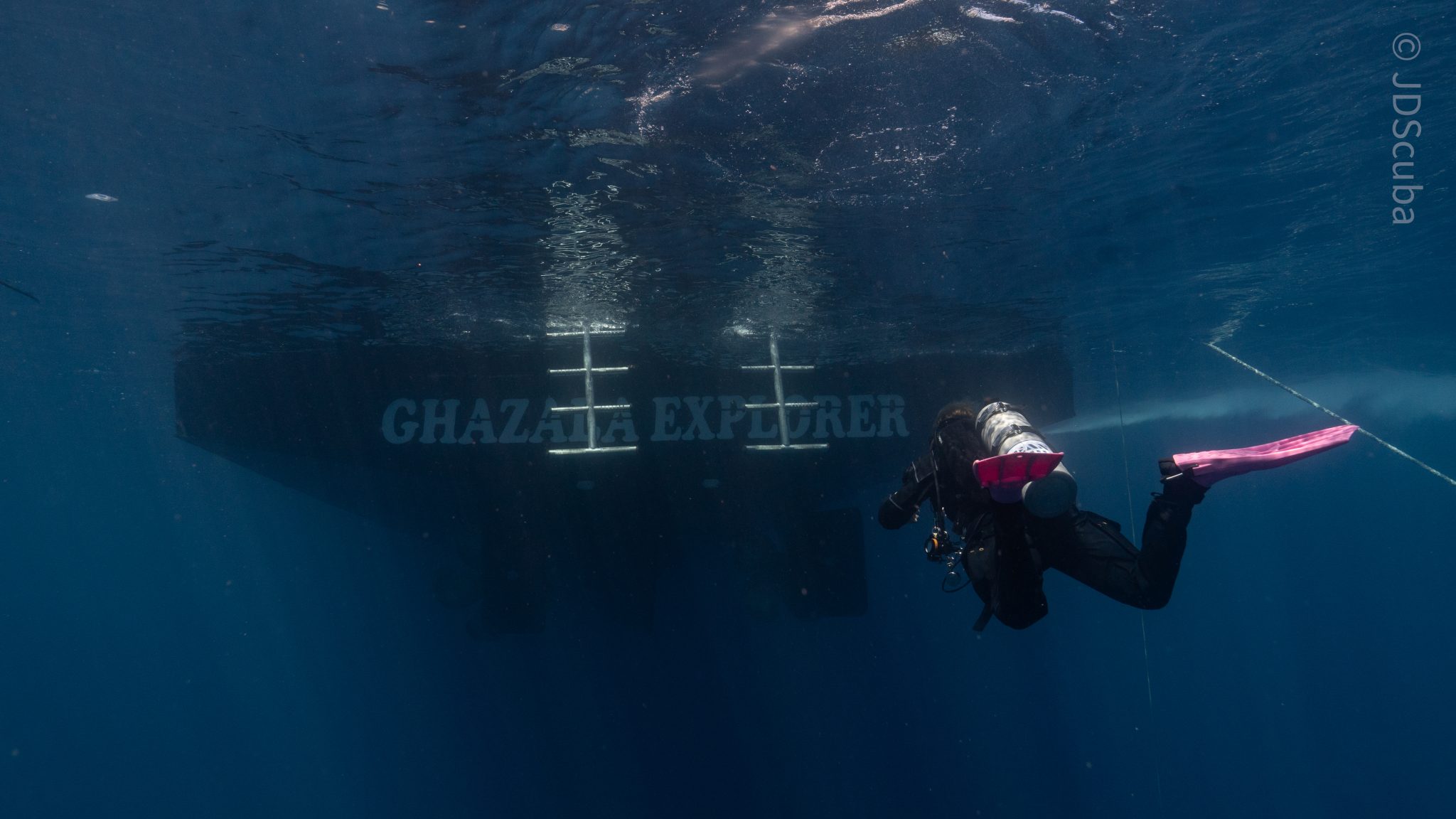
Departing from Hurghada, the plans were to head north for the first couple of days, including check dives on Global reefs, before then heading to see a few of the wrecks at Abu Nuhas reef. Then we would head across the Gulf of Suez into Ras Mohammed National Park to see what are considered to be some of the best reef dives in the Red Sea. From there, we would head to the Strait of Tiran for a day, then head back south to dive the world-famous wreck and one of the trip’s highlights: the SS Thistlegorm. This would include a night dive prior to heading back for the final day’s diving around Hurghada before heading back to port.
Arriving from Gatwick into Hurghada late in the evening, the Scuba Travel rep was waiting for arrivals ready to take us all to the Ghazala Explorer, docked in Hurghada’s New Marina. Stepping onboard, the high-quality and spacious deck spaces and interior provided an instant sense of comfort. There was a friendly welcome by the crew and guides. After some food, it was time for the boat briefing, which was detailed and covered all the important safety aspects of the vessel and procedures. The kit was then set up in the allocated spaces, and the spacious tables in the interior provided the perfect place to build up my camera ahead of the week’s trip. As soon as everything was done, it was time to head to the cabin to get some rest before an early start for a check dive.
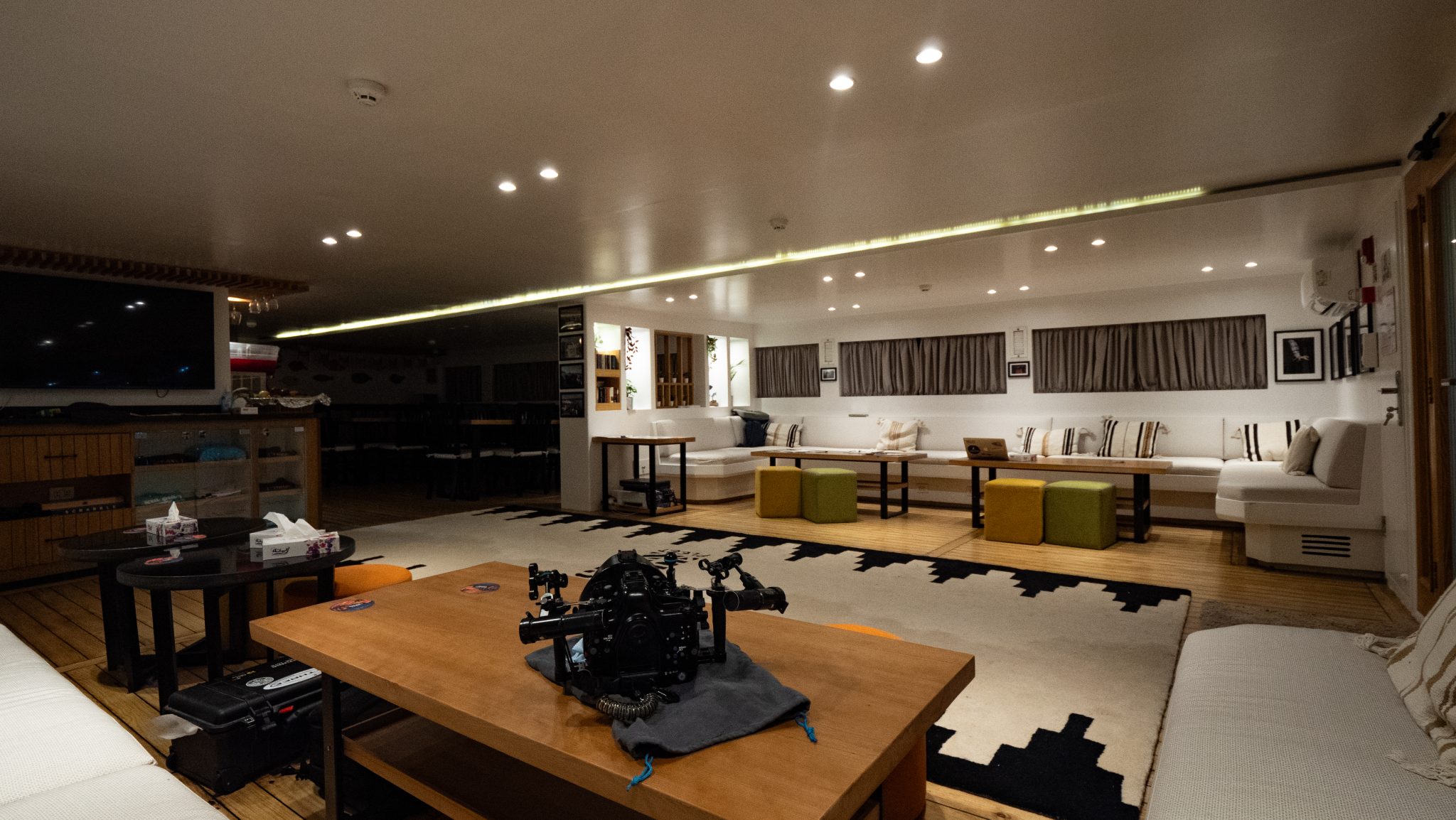
The northerly wind provided a chop, but it wasn’t felt as the steel hull of the vessel cut through each wave. By mid-morning, we were moored up at the reef at Gobal Island, sheltered from the chop on the other side. With Ahmed providing a detailed briefing, it was time to kit up and get in the water to explore some of the reefs below during the check dive. It’s always exciting to stand on the stern of the boat, looking into the clear blue water before taking a stride entry to enter the colourful coral scenery below.
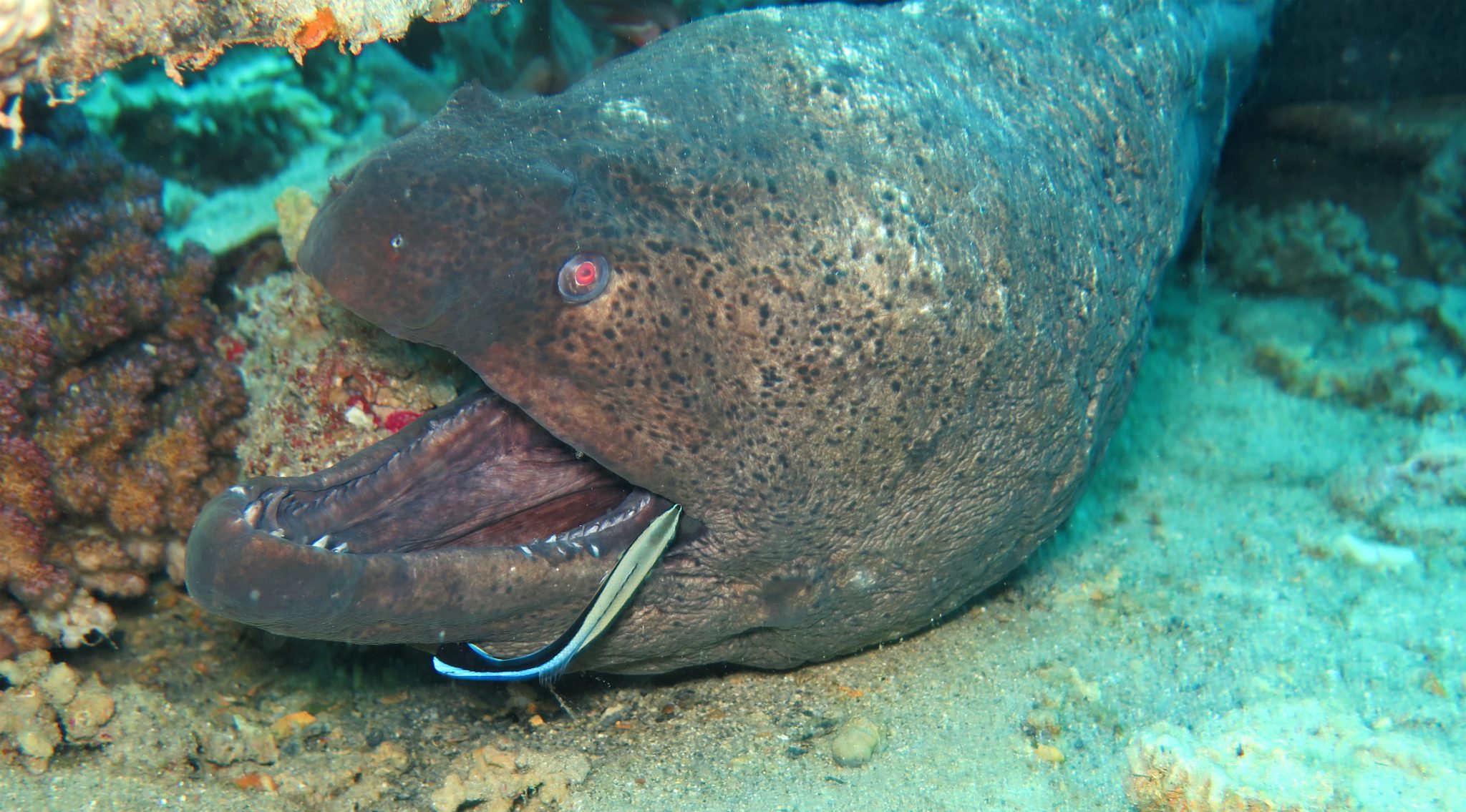
Like most of the dives on coral reefs in the Red Sea, the colours and busyness of the reefs were great to see. It was great to be back on the reefs, taking the time to watch the many species which make up the Red Sea ecosystems before picking out a few to film and photograph. The time flies by as you are constantly engaged with the surroundings, and then before I knew it, it was time to head back onboard, where everyone coming back from the water had big smiles and were full of excitement and anticipation for the rest of the week.
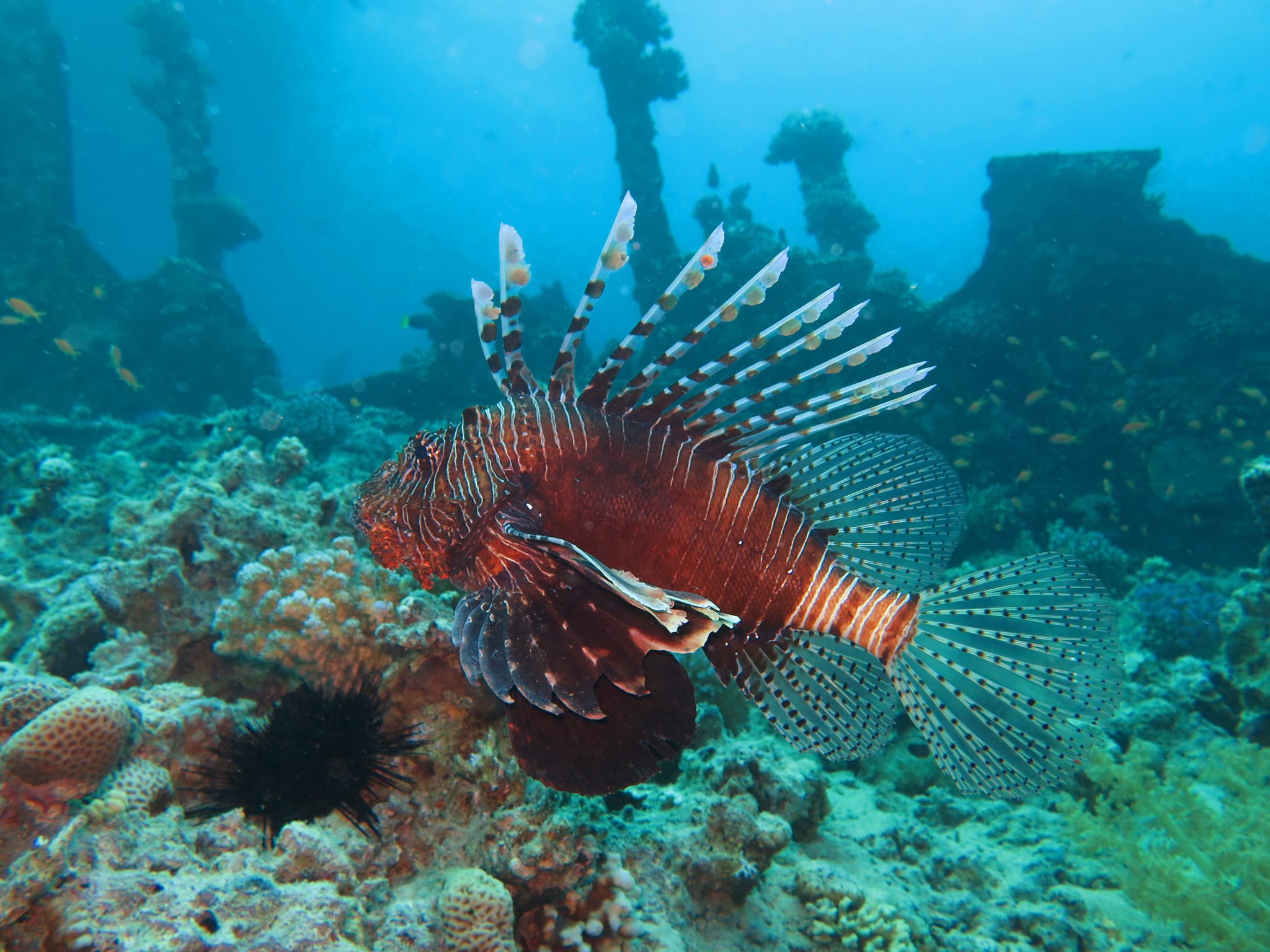
The next two dives, which included the night dive, were on the wreck of the barge, where very little remains act as an artificial reef for many species, which included a few perfectly hidden large stonefish and a crocodile fish camouflaging on the sand beneath the hull. Looking up though was the highlight of the dive, as a squad of squid could be seen mid-water, dancing around. Ascending slowly and calmly, I was able to position myself amongst the squad for the opportunity to get a few close-ups of this great species. Shortly after, the squid were then accompanied by a shoal of halfbeaks just below the surface. Everywhere was just full of life!
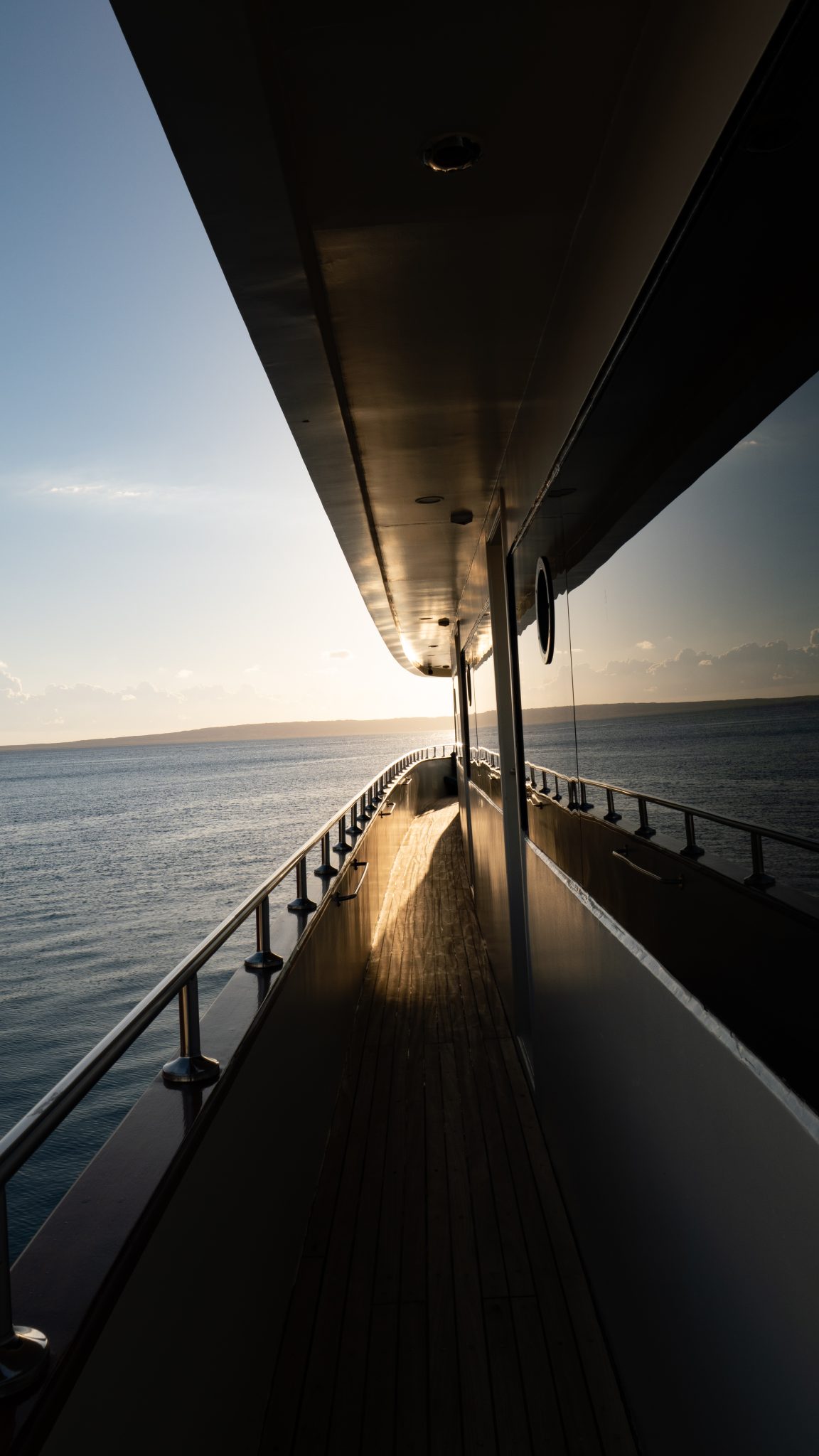
After some afternoon snacks, and as part of the safety protocols of the vessel, it was time to practice an emergency drill to put the briefings into action. The fire alarm rang, and we then had to carry out a full drill of getting the life jackets and using the closest emergency exits to then gather at the muster point on top deck where we would then have a run-through of the life rafts. The drill was great to do and I thought it was a really important part of the boat’s safety, as it was an opportunity to use the emergency exits to ensure a safe and effective evacuation, while also convening at the muster station to go through different scenarios and become familiar with some of the kit used during these emergencies.
Check in for Part 2 from Jake tomorrow!
To find out more about the Northern Red Sea reef and wrecks itineraries aboard Ghazala Explorer, or to book, contact Scuba Travel now:
Email: dive@scubatravel.com
Tel: +44 (0)1483 411590
Photos: Jake Davies / Avalon.Red
-

 News3 months ago
News3 months agoHone your underwater photography skills with Alphamarine Photography at Red Sea Diving Safari in March
-

 News3 months ago
News3 months agoCapturing Critters in Lembeh Underwater Photography Workshop 2024: Event Roundup
-

 Marine Life & Conservation Blogs2 months ago
Marine Life & Conservation Blogs2 months agoCreature Feature: Swell Sharks
-

 Blogs2 months ago
Blogs2 months agoMurex Resorts: Passport to Paradise!
-

 Blogs2 months ago
Blogs2 months agoDiver Discovering Whale Skeletons Beneath Ice Judged World’s Best Underwater Photograph
-

 Gear Reviews2 months ago
Gear Reviews2 months agoGear Review: Oceanic+ Dive Housing for iPhone
-

 Marine Life & Conservation2 months ago
Marine Life & Conservation2 months agoSave the Manatee Club launches brand new webcams at Silver Springs State Park, Florida
-

 News3 months ago
News3 months agoWorld’s Best Underwater Photographers Unveil Breathtaking Images at World Shootout 2023



